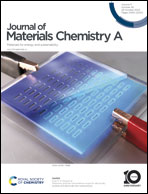Remodelling the chlor-alkali electrolysis process to co-generate useful reduction products from CO2†
Abstract
Converting CO2 into usable chemicals and fuels electrochemically is a promising method to close the carbon cycle and store intermittent renewable energy. However, on combining it with a typical anode, the oxygen evolution reaction (OER), results in both high energy consumption and produces only oxygen of little commercial value. Conversely, the chlor-alkali process is an established and profitable electrochemical process that produces Cl2 and alkali (KOH). Herein, we demonstrate the feasibility of integrating the chlorine evolution reaction (CER) together with the CO2 reduction reaction (CO2RR) to co-generate C4 (2,3-furandiol) and C3 (methylglyoxal) products. At a cell current of 1 mA, the system produces Cl2 with a faradaic efficiency (FE) of ∼80% and CO2RR products at 100% faradaic efficiency without losses from crossover or degradation of the cathode. High faradaic efficiency is achieved for CO2RR products at higher current densities using a nickel phosphide Ni2P catalyst synthesized by a low temperature soft-template method. A technoeconomic assessment is presented that quantifies the economic advantage of combining the co-production of methylglyoxal and Cl2 by integrating these two electrochemical processes.



 Please wait while we load your content...
Please wait while we load your content...